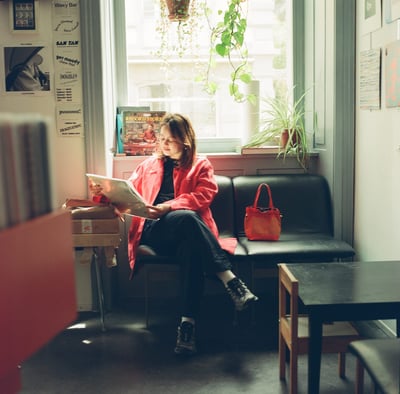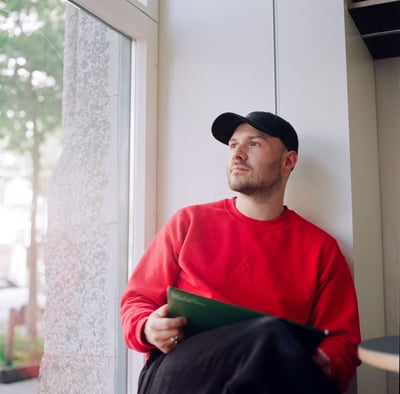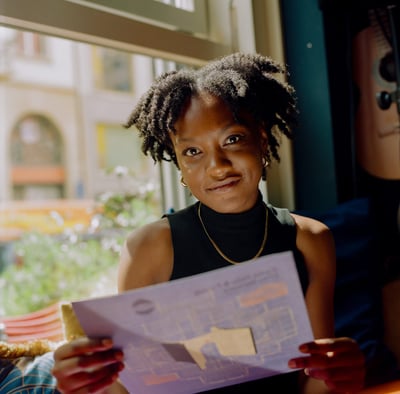What’s Up with The London Jazz Scene?
What’s caused jazz’s resurgence, what makes London different, and where are the essential places to go to hear this new scene for yourself? Guitarist Jelly Cleaver lets you in on London’s jazz secrets.
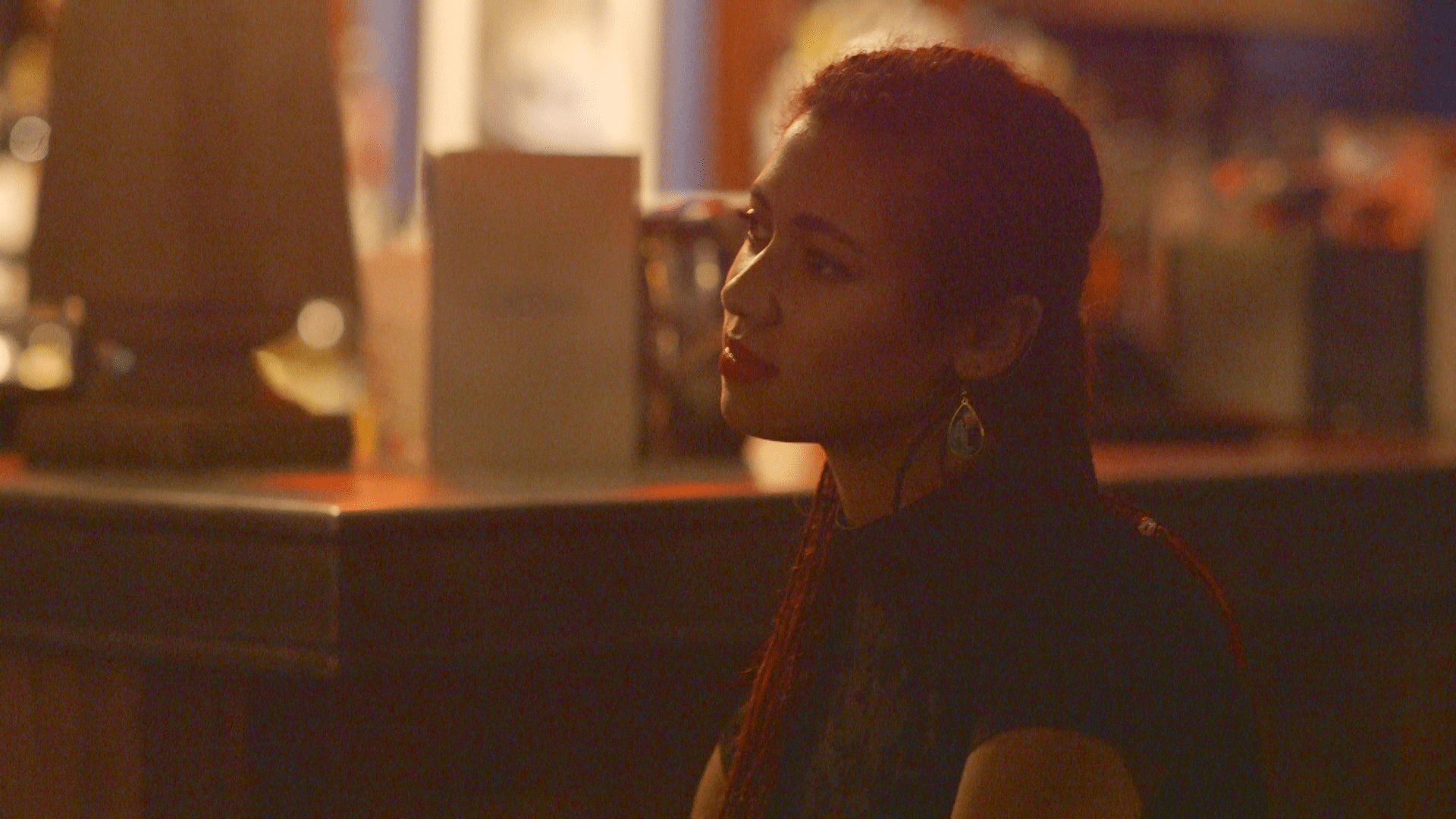
It seems recently that anyone who’s got their ear to the ground is talking about the London jazz scene: London’s newest trend of underground music. Spotify has found that the number of people under 30 listening to their flagship UK jazz playlist has more than doubled in six months. This year’s Field Day Festival, often associated with more electronic music, accompanied its move from East London to Brixton by filling up most of its Friday line-up with jazz artists. International interest is also turning towards the London scene and the acts that have sprung from it.
We Out Here
The New York Times just published a whole feature on a particularly sweaty jazz night located in a small, crowded room in Deptford. This November in the Netherlands, within two days of each other ‘Crossing Border’ and ‘So What’s Next’ Festivals are both dedicating whole evenings to the young London scene, featuring panel discussions and live performances from its breakout artists like Moses Boyd and Nubya Garcia.
We Out Here, a documentary by the record label Brownswood to accompany an album that attempted to capture as best it could the London jazz scene and its stars as the year began, has now been screened across the world. Those with leading roles in the film like Ezra Collective and Shabaka Hutchings, who was the album’s musical director, keep on selling out their world tours.
What is it that makes this scene so exciting? How has it shaken the stuffy and elitist image, the idea that jazz is just bad Frank Sinatra impersonators or abstract and self-indulgent ten-minute sax solos, to become instead a truly dynamic and relevant music that can speak to young people and draw a crowd? What are the venues, the promoters, the labels and the players doing that is so different? What is feeding the scene?
Late-night jams in non-jazz venues and unassuming bars
When I first came to London two years ago, I’ll admit I was initially disappointed by a jazz scene that, despite my high hopes, appeared to be as they say “male, pale and stale”. The old adage that jazz is only for elites and old people seemed, sadly, to be true. The music I heard was frozen in time, with no updates in the last seventy years. What really depressed me was that most of the musicians I saw played with such little passion; it was like they wanted to be anywhere else but playing music with other people on stage. It was boring to watch no matter how technically good the music was. Stale.
But as I got more into the jazz scene. I realised the best places to go were more underground. It was all happening in small and traditionally non-jazz venues, unassuming bars and at late night jams. I started to learn the regular nights to head down to and the players to look out for. You start going to check out new jams and you realise you can’t stop – there’s so many!
"Often the jazz venues we do have are up against it with expensive licences and noise complaints by local residents." – Jelly Cleaver
The energy that comes from being in a small room, often shared with less than 100 people, hearing incredible, improvised music that is completely new and made in response to every single person in that room, will never be played in the same way again, is pretty electric. And while there are several new dedicated jazz venues appearing, London’s jazz isn’t segregated from other styles.
Perhaps due to modern music tastes having a greater acceptance of genre fluidity, jazz is played in pop and punk venues, everywhere from Village Underground in Shoreditch to Off the Cuff in Brixton. Lots of progressive gig venues in London are programming in jazz acts or giving it a whole day a week, knowing it’s not going to be a flop. And DJs are spinning jazz in their sets, assured that it’s as likely to get people on the dance floor as disco or house music.
Often the jazz venues we do have are up against it with expensive licences and noise complaints by local residents. Recently Total Refreshment Centre, which had been a really important and supportive hub, was shut down by the local council, leaving a big hole in the scene. But these venues are run by great, dedicated people who are led by their passion for music.
Ghost Notes in Peckham is a really nice spot dedicated to treating musicians right and serving up delicious vegan food on the side. It’s got the support of a regular local crowd and tends to be a hang for musicians, and on top of that, most of its nights are free entry, with live bands, jams and DJs.
Another important mention needs to go to Jazz Re:freshed. Started about fourteen years ago and continued through sheer hard work by Justin McKenzie, Adam Moses and Yvette Griffith, it is now recognised as an essential tastemaker on the scene. They’re not just known locally; they’ve taken bands internationally, bringing British acts to Afropunk in Paris and SXSW in America. It all started through their weekly residency at Mau Mau in West London.
Every Thursday night 10-11 pm for just £5 entrance, it’s a great place to hear new bands and the quality is always guaranteed. It is (like most jazz gigs) an intimate space to see bands and it can get quite crowded on popular nights. It makes it difficult as people keep jostling through the crowd to get to the toilets, which are located on either side of the stage behind the band.
If you don’t fancy that experience, their gigs are filmed in high quality so you can see what you missed last Thursday or relive the experience on Youtube. As well as being promoters, Jazz Re:freshed also do festivals, film nights, a record label and even a clothing line – they make those ‘Smooth Jazz Sucks’ t-shirts you’ve probably seen everyone in the jazz scene wearing. As a label, they were the first to release EPs (or 5ives) by Nubya Garcia, Triforce and Ashley Henry, which are all essential listening.
The place of the more established jazz clubs, Ronnie Scott’s and Pizza Express, is still important. They’re expensive, traditional, and some would dismiss them as a tourist trap, but they are undeniably a great place to take your nan or go on a date. They have the ability to draw huge international jazz artists like Marcus Miller and Chick Corea (by charging £50 per ticket), but they do sometimes programme up and coming bands too. Ronnie Scott’s liberal student discounts and the ability to glide on through without paying if you look like you could play an instrument means that it’s still popular with music students, who tend to head down to their late jams around midnight.
Also, look out for regular residences in unlikely places. Prince Albert in Brixton has Mark Kavuma and The Bangers Factory every Thursday 11 pm - early am. And the Terry Smiles Collective can be found in the corners of various cocktail bars. When musicians need somewhere to play they’ll generally find a way, and the result is that you get people trying to dance to bebop at 2 am.
These venues are all really important to hear new bands performing their originals. However, as you’d expect from jazz, the real action is always at the jams. New jams hosted by different house bands pop up all the time in pubs, venues and cocktail bars. They’re generally not friendly for those who like early nights, with many of them only starting to kick off at 11 pm.
"London’s jazz scene has more jams than evenings, with several going on every day of the week." – Jelly Cleaver
Steamdown has to be one of the most exciting places to go, and word is spreading. Every Wednesday night, more people than probably legally should squash into a room to sweat together and listen to jazz, and by the time the night is done the windows have literally steamed over. Last week the bouncers were already turning people away at 8:30 in a loose attempt at crowd control. The house band at Steamdown is a who’s who of the scene and is sometimes joined by international artists like Kamasi Washington who pop down for a surprise appearance.
In October they had an all-star line-up for a special Steamdown Orchestra gig at the Jazz Café, featuring Theon Cross, Nubya Garcia and Eddie Hick. It represented a real celebration of the scene, and a moment to reflect on how well supported Steamdown has become, bursting out from those packed nights at Buster Mantis to playing at festivals, the V&A, and setting up new residencies at Laylow in West London. People keep coming and more people want to join. Wayne Francis, who runs the jam, has created a really special thing. Unlike most leaders though, he shares it around, so everyone can feel ownership of it. Often asking who’s new, there’ll always be some new people joining the regulars. If you go you can’t help but tell ten people because it’s such a good hang. When you know, you know.
So many gigs, so little time
London’s jazz scene has more jams than evenings, with several going on every day of the week. Ghost Notes host jams on Tuesdays with a biweekly line-up change. One week is jazz standards led by Axel Kaner-Lidstrum, mysteriously called ‘Ataraxia’. The next is ‘The Spaces in Between’, a more groove-based jam with specially invited guests such as Sheila Maurice-Grey or Mark Kavuma, and the odd surprise pop-in by Tom Misch or Jordan Rakei. For that one, Jake Long (Maisha), Rudi Creswick (Tom Misch) and Jack Stephenson-Oliver (Vels Trio) make up the house band.
Oliver’s Jazz Bar in Greenwich may be small but it's where many of the students from Trinity’s jazz course tend to head after lectures, so the standard of standards is quite high. Troy Bar in Hoxton is the place to go if you love neo-soul but get there early at 11 pm to order a plate of home-cooked Jamaican food. Some say Tuesdays are the night to go, others say Fridays, the dedicated go “most days”. If you don’t fancy the weekly sauna at Steamdown, Grow in Hackney Wick also do Wednesday jams led by Rio Kai. Some late nights on Thursdays it's worth venturing down to Orleans, (the one in Finsbury Park not Louisiana). And Sunday, God’s day, naturally seems to be the universal day of jazz jams with the White Hart in New Cross, biweekly at Cattivo's in Brixton with Nihilism as the house band, Bar 91 in Hackney, and finishing off at the Haggerston for a heavy way to bring the week in.
The jam scene in London has created a culture of collaboration, and an intuitive sense of where to take the music in order to get a reaction out of the audience. It also breeds a high level of musicianship. These musicians play together regularly and hang out, nurtured from the same ground, forming real bonds and friendships. But each takes their turn at becoming a bandleader while playing in each other’s bands. What happens is that each band somehow becomes a supergroup, not just because the players in it have become well known, but because of an ease of playing together that comes through time, and through literally growing up together.
And it is growing up together because one of the most notable things about the scene at the moment is its youthfulness. A lot of the players getting names at the moment aren’t even out of their teens, and the majority touring the world now are in their twenties. Shabaka Hutchings, at the grand old age of 34, is seen as a respected elder.
Becoming the language of the times
The youthful element is extremely important as, like in most genres, from punk to grime, it is the new generation taking the music and shaping it for their own world that makes it so innovative and vital. It allows the London jazz scene to maintain the roots of jazz as an ever-evolving social music. Originating in New Orleans at the turn of the twentieth century, jazz arose from a melting pot of social circumstance: African drumming rhythms, French military marching music, Caribbean, Spanish and Scottish populations, gospel and spirituals, brothel houses, barn dances, riverboats and funeral parades. Jazz becomes the language of the times.
Despite not being from jazz’s country of origin, the United States, the young London jazz scene manages to keep the spirit of jazz alive. It is able to authentically reflect the times and the people making it. Today’s jazz absorbs the flavours of today’s music, allowing it to reach new audiences who might have previously not been into “jazz”.
One big influence, drawing from London’s vibrant club culture, is electronic dance music. Touring in Sampha’s band and mentored by Floating Points, Moses Boyd has been experimenting with analogue synths, combining it with his melodic drumming in his last EP, Absolute Zero. Henry Wu (or Kamaal Williams, or however he wants to refer to himself), has made dance-friendly jazz in Yussef Kamaal and now in Kamaal Williams, transferring his background in house music to his unique keyboard approach.
As a guitarist myself, I’m really excited about how London’s jazz guitarists aren’t afraid to experiment with rock influences, while all taking really different approaches. Oscar Jerome has the classic sound of Jimi Hendrix under his fingers. Mansur Brown takes it to the stadium rock of epic, lightning-fast solos, and in his album, Shiroi adds more ambient sounds with huge reverbs and delays. Shirley Tetteh’s new project Nardeydey somehow combines all the best elements of indie rock and alt-pop, sounding like if the members of Vampire Weekend had all done jazz undergrads.
Artists have taken jazz’s ability to absorb the music of other cultures and used this to comment on their cultural identity. Camilla George, Zara McFarlane and Cherise Adams-Burnett have all taken their Caribbean heritage and used it to vocalise not just the musical timbre of their culture but also to express their narrative in this multicultural city.
Jazz can naturally comment on the Windrush generation and their descendants; their culture and history are in the music. This year fittingly is the 50thanniversary of Trojan Records, the first label for Jamaica music that enjoyed wide appeal in the UK, popularising classics like Police and Thieves and My Boy Lollipop. It’s an important anniversary to remember when cultures gained from colliding.
"One of the most crucial factors in the new scene is that jazz has gone from a sit-down-and-clap situation back to its original purpose: dance music." – Jelly Cleaver
Afrobeat has been hugely important for the London scene, especially for London’s large population of second-generation immigrants who want to connect with their African heritage. It’s a way to celebrate their culture and their story despite Britain’s uncomfortable history of colonialism. One stand-out band is Kokoroko, whose track Abussey Junction, recorded as part of the Brownswood We Out Here complication has over 10 million streams on Youtube.
On the scene, there are bands playing every style and period of jazz, from bebop to big band, but one style that seems to be having a moment could be vaguely called spiritual jazz; the sound of the 1970s, typified by saxophonist and undoubted visionary, Sun Ra. Bands like Maisha and Where Pathways Meet are channelling this entrancing sound, using simple, pure melodies and rhythms that relate to people.
One of the most crucial factors in the new scene is that jazz has gone from a sit-down-and-clap situation back to its original purpose: dance music. At most of the gigs, people are standing up and dancing. By getting into the grooves and throwing some moves, the energy and engagement completely transform. The veil between audience and musician goes and it’s all just one big celebration, with everyone responding to each other.
More Women in jazz and the importance of mixing it with other genres
Jazz is also making use of a lot of dance music’s features: the lifts, the beats, the builds, and of course the bass drops. Just look at a crowd responding to Sons of Kemet, with Theon Cross laying down a DnB-worthy bass line against two drummers; it can only be called a rave. Improvised forms of dance, music and spoken word come together at the Floor Ripper sessions in Hootananny. Go on the third Wednesday of the month and you’ll find break dancers freestyling in a circle, backed by a jazz band and MC Cypher.
Jazz and hip-hop go way back with an important shared history, but it’s not just in the States where jazz titans like Kamasi Washington began their careers in the bands for rappers like Snoop Dog. Here, Shirley Tetteh played in Little Sim’s band, and Loyle Carner has collaborated with Tom Misch and Jordan Rakei. Jazz and spoken word also combine at Spread the Jam nights at Off The Cuff. After the spoken word sessions run by Slam the Poet, some poets continue to take the mic once the jazz jam kicks off.
One notable thing where London’s jazz scene thankfully breaks from a bad tradition is that there are now far more women making music. The cutting sessions from jazz’s New York hay day were notoriously masculine and aggressive. Players would literally “battle” each other with their solo virtuosity (and sometimes beat each other up afterwards). Jazz pioneers from Charlie Parker to Ornette Coleman talk about being laughed out of a jam at an early stage in their careers.
The London jazz scene is much more inclusive, supportive and peaceful. A lot of women are bandleaders and composers at the top of the game, like Nubya Garcia, Cassie Kinoshi and Sheila Maurice-Grey. And there’s more female talent coming through. Look out for musicians like Roella Oloro, Caroline Scott and Isobella “Izzy” Burnham, all members of Tomorrow’s Warriors Female Frontline, who are already leading their own bands and playing and touring with artists like Connie Constance.
Another important element that leads out of it being such a young scene is that the players are more willing to take chances and embrace a more DIY approach, making the music able to survive and thrive. Today’s artists are more business savvy and many release music on their own labels. They also understand the importance of social media as a way to connect to their audiences.
Credits and the friendliness of a whole scene
So, what makes this scene flourish? Look to the roots and you’ll find the gardeners. Although London has some of the best conservatories in the country for formally studying jazz, there are also individuals, organisations and publications, without whom the scene would not be half of what it is today. A shout-out needs to go to those who always shout about the scene and help spread the music. Jazz may have just broken into Radio 1Xtra with Moses Boyd’s new residency, but radio stations like WorldWide FM, NTS, Balamii and Netil keep their ear to the ground for new talent to put through.
There are also several organisations supporting the youth and giving them a foot up. DJ Gordon Wedderburn of GW Jazz has his own radio show and runs regular nights at The Duck and Rice in Soho and The Job Centre in Deptford promoting up-and-coming bands. He adds his immense energy to the scene, always reminding you that you are very lucky to be witnessing such a crucial moment in jazz history. Pat Pascal, the mother of two very gifted young musicians, set up Jazz New Blood and has given many talented teens their first taste as bandleaders.
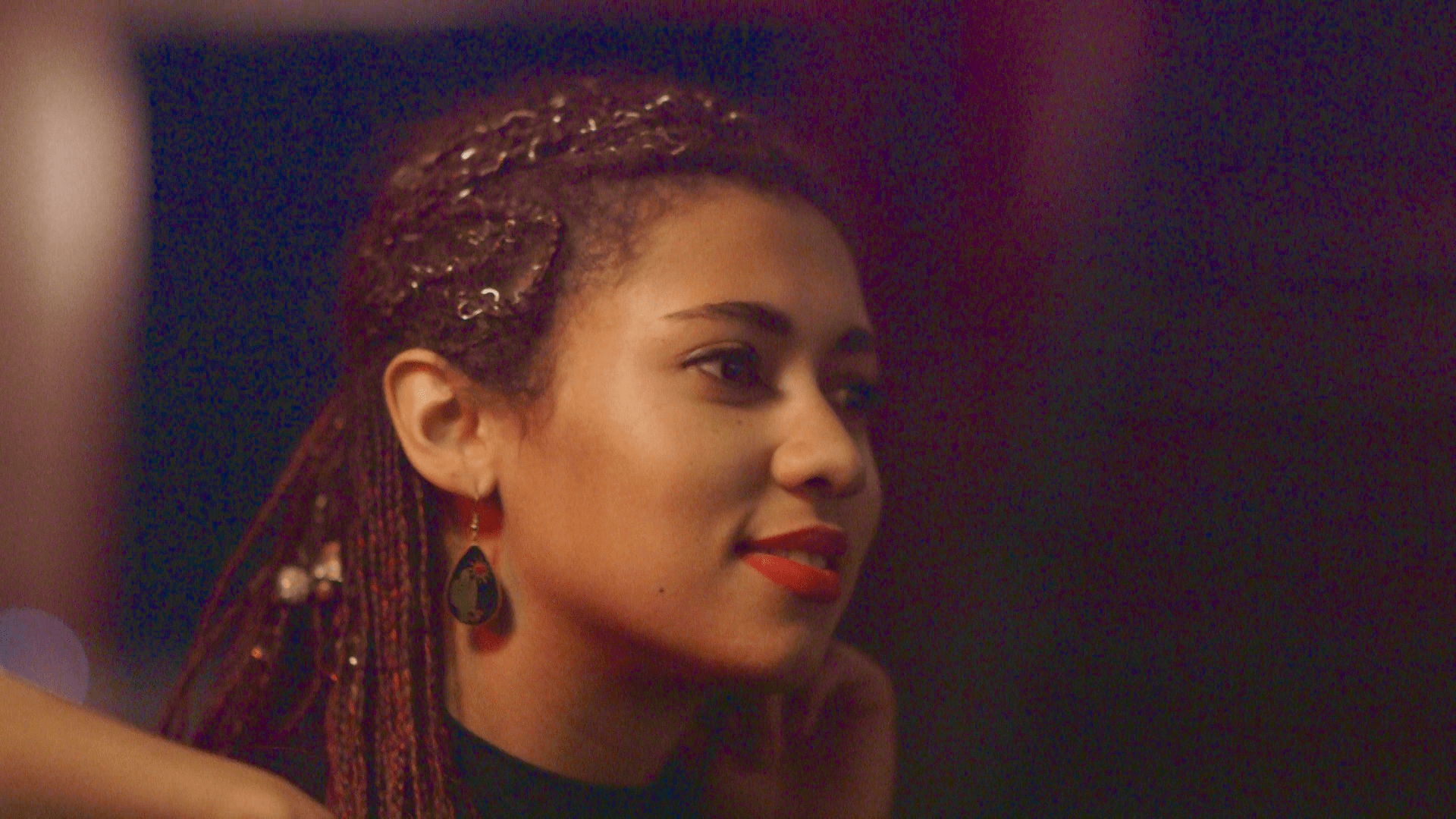
Credit has to go to Tomorrow’s Warriors, founded by Janine Irons and Gary Crosby, who run jazz workshops for young musicians on an almost-daily basis, all free of charge. They’ve channelled their energies over the last 27 or so years (they argue about how long it’s really been) into diversifying the scene, and through nurturing several generations of BAME and female musicians they have literally changed the face of jazz in London. Lookup any jazz musician making it big today and chances are they’ve passed through Tomorrow’s Warriors at some point.
If you really want to have a glance into the future of UK jazz, come to a Tomorrow’s Warriors jam at Rich Mix, Shoreditch on the second Sunday afternoon of the month. This is where you’ll see the real young talent, with 13-year-olds already playing ‘trane licks.
"I’m not saying improvised music could solve all the world’s problems, but maybe we can all learn something from the London scene. And we can definitely enjoy the music" – Jelly Cleaver
I am unbelievably excited about the future of the London jazz scene. Just looking at the players coming up, the standard is already immense, and many of them are only about to release their debut album or EP. In the immediate future make a mental note to check out Zeῆel, Nihilism and Invariance. But it’s where the scene will be in 10 years’ time that’s so interesting, and I’m looking forward to it.
But, the absolute most important thing about this scene is that it’s so friendly. Having moved to London not knowing many people, the jazz family has made this city a home for me. It’s maybe a bit essentialist to say jazzers naturally have more friendly and open personalities, but speaking to friends about it one said “when you get up to solo, you’re putting your soul on the line. You have to expose yourself and make yourself vulnerable, because you have to speak your truth”.
What you’re hearing with jazz is people expressing themselves in their rawest forms. As well as that, to jam with other people (if you do it well), means that you have to listen to each other, respond to each other, and respect each other’s space. I’m not saying improvised music could solve all the world’s problems, but maybe we can all learn something from the London scene. And we can definitely enjoy the music.
Jelly Cleaver is a guitarist, producer and singer-songwriter based in South London and has been called 'one to watch for sure' by BBC 6 Music's Gilles Peterson. For 45rpm.ch she reveals the secrets of the London jazz scene.
